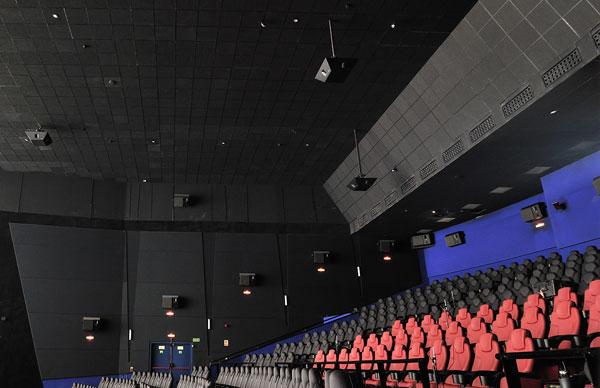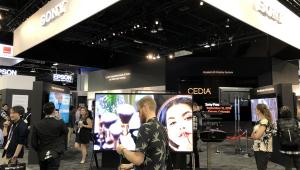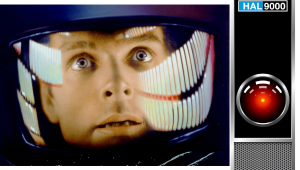Beyond 7.1

Imax and 3D theaters have helped, but they command even higher prices. The next big thing for theater owners may be what promoters have dubbed 3D sound. Instead of the theaters' current complement of 5.1 or 7.1 channels, 3D sound gives you moremany more. Several companies are working on such systems, but Imm Sound, based in Barcelona, Spain, appears to be ahead of the game, currently sporting 30 theaters worldwide, with more on the way.
Only two of those theaters are in the U.S.: one in Las Vegas, NV (opening soon) and another in Glendale, CA, just outside Los Angeles. On April 17, Imm Sound presented a demo to a number of press and technical personnel at the Pacific Theaters Glendale 18 in the Americana shopping complex, and I was there.
Imm Sound's system consists of 23.1 audio channels (!) distributed around the theaterat different heights, side and rear surrounds, and even directly overhead as seen in the photo above. Several of the channels in the Glendale 18 auditorium consisted of a cluster of more than one speaker, aimed for wider angular distribution. Such clusters count as only one of the 23.1 channels, however, so the system we heard actually had more than 23 full-range speakers.
The company expects that producers who opt for this system will mix their soundtracks with 23.1 discrete channels. But since that's unlikely for all future films, the system is also compatible with standard 5.1 and 7.1 soundtracks. Using proprietary algorithms, it upconverts these conventional mixes to make use of the 23.1 available channels. For theaters that cannot or will not invest in a full 23.1 array of speakers, smaller arrays can be used. But Imm Sound considers 14.1 to be the smallest package that can retain most of the benefits offered by the system.
Needless to say, such soundtracks are compatible only with digital projection in which the audio is stored on a server along with the picture. I doubt it's possible to include a 23.1 soundtrack on actual film.
For a discrete 23.1-channel production, sound mixers will be able to use many of the tools currently available to them, supplemented by processors from Imm Sound. An iPad may also be used to better visualize where the mixer wants to position various sounds.
The mix is not produced by directing the sound to specific speaker channels. Rather, the mixer directs each sound to the location in the auditorium where he or she wants that sound to originate, and these locations are encoded in the mix. The Imm Sound processor decodes them in a way that sends the sound to the speaker or speakers that will produce the desired effect. Since theater setups will necessarily vary somewhat in the number of channels, layout of the speakers, and size and shape of the auditorium, each theater's Imm Sound processor can be programmed to account for these differing parameters.
After a brief technical discussion, we were treated to several short demos, both discrete mixes and upconverted 5.1 and 7.1 soundtracks. There was significant edginess to some of the soundlikely due to the mixes themselves, the theater's speakers and equalization (probably set for a full house rather than a small audience), and excessive volume (a plague in Los Angeles theatersand I listen to my own home theater loud!).
But the main subject of the demo was directionality and immersion, and the results from the discrete Imm Sound mixes were astonishing. I'm not sure this type of sound will be necessary or even desirable for many moviesit's so effective it can be distractingbut for today's popular action and animated flicks, it will surely put more of those proverbial asses in the seats.
The upconversion demos were satisfactory, but I'd have to hear them side-by-side with basic 5.1 or 7.1 to determine if the benefit is worth the extra bucks theaters will surely charge. And that's an important issue. It's akin to the created-in-3D vs. converted 3D conundrum. Given good production quality, audiences will definitely hear what they are paying for with a discrete Imm Sound mix. But with an upconversionwhich will comprise most of the material available to the system for the foreseeable futureI'm not so sure. In any case, the first film to be produced with a full 23.1-channel upmix will be The Impossible.
The presenters also dropped hints about the system being available for home use. But that raises a slew of questions. How much will it cost? (The processor itself appears to be affordable.) Can all those extra channels be carried on today's best home sources without reverting to lossy compression? (Doubtful, with 3D's demands already here and 4K on the horizon.) And how soon after those 23.1 speakers are installed will the divorce papers be served?!





























































